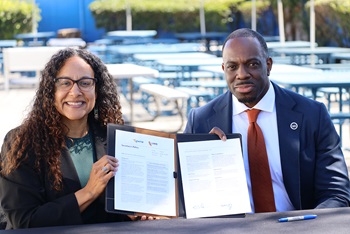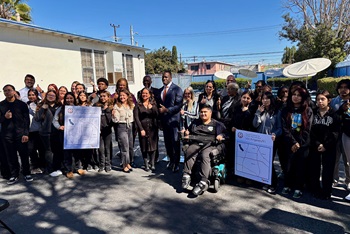Enforcement and Safety
The priorities of California’s transportation system have evolved over the last several decades, from systems first built around the automobile, to the complex and vast multi-modal networks we have today that, in addition to the car, support motorcycles, bikes, pedestrians and public transportation.
One of our key missions here at the California Transportation Agency (CalSTA) is ensuring we work with our departments and partner agencies to develop programs and policies that best support and adapt to these more dynamic transportation networks and ensure the safety of the traveling public – regardless of whether they are drivers, bikers, riders or walkers.
Please use the resources below to learn more about what we are working on.
Secretary's Policy on Road Safety
- Secretary’s Policy on Road Safety (PDF)
- CalSTA Press Release
- HHS Blog Post About Data-Driven Road Safety Initiatives and Joint Policy
- Press Event Video (YouTube link)
The joint Secretary’s Policy on Road Safety (CalSTA and CalHHS) establishes an interim goal to reduce fatal and serious injury crashes by 30% on California roads by 2035. Through a public health, prevention-first, investment mindset that targets the root causes of traffic crashes, the policy commits to institutionalize the Safe System Approach (SSA) across departments. The intent is to align planning, design, operations and evaluation with the three key crash risk factors:
- exposure (how often/how far people travel)
- likelihood (the chance of a crash occurring)
- and severity (the consequences when the crash does occur).


State Priority Safety Corridors
The State Priority Safety Corridor initiative demonstrates California’s renewed commitment to preventing fatal and serious injuries on our roadways. These corridors apply the Safe System Approach, now formally adopted through the Joint Secretary’s Policy on Road Safety, into action at the corridor scale. Each corridor is prioritized and supported but data as a high-injury location where State, regional, and local partners will apply the Safe System principles of prevention, shared responsibility, and equity to reduce harm and save lives.
Current Corridor projects
Autonomous Vehicles in California
Under Senate Bill 1298 (Chapter 570, Statutes of 2012), the California Department of Motor Vehicles is required to adopt regulations governing both the testing and public use of autonomous vehicles on California roadways. The primary focus of the deployment regulations is the safety of the autonomous vehicles and the safety of the public who will share the road with these vehicles.
AB 60
As of January 2015, California residents who cannot establish legal presence in the United States may apply for a driver’s license at the California Department of Motor Vehicles if they can show eligible proof of identification and residency in the state. These driver’s licenses may not be used for identification purposes. By law, no one may discriminate against a holder of an AB-60 license, or use this license to attempt to question the holder’s citizenship or immigration status.
Zero Traffic Fatalities Task Force
Assembly Bill 2363 (Friedman, Chapter 650, Statutes of 2018) established the Zero Traffic Fatalities Task Force. The statutory goal of the Task Force was to develop a structured, coordinated process for early engagement of all parties to develop policies to reduce traffic fatalities to zero. The Task Force also examined alternatives to the 85th percentile as a method for determining speed limits in California.
SB 1046
Commencing January 1, 2019, and until January 1, 2026, a person who has been convicted of driving a motor vehicle under the influence of an alcoholic beverage, as specified, is required to install for a specified period of time an ignition interlock device on the vehicle, as ordered by the court, that is the vehicle that he or she operates. If a person maintains an ignition interlock device for the specified required time, DMV must reinstate the person’s privilege to operate a motor vehicle at the time the other reinstatement requirements are satisfied. The bill also requires CalSTA to assess the program and report to the Legislature on the outcomes of the program no later than January 1, 2025.
Related Programs and Departments
- Autonomous Vehicles Strategic Framework
- Broadband Deployment
- CalSTA Infrastructure Investment and Jobs Act (IIJA) Implementation
- Climate Action Plan for Transportation Infrastructure (CAPTI)
- Enforcement and Safety
- Freight, Rail and Border
- Reports
- SB 125 Transit Program
- State Rail Assistance Program
- Transit and Intercity Rail Capital Program
- Transportation Funding in California
- Transportation and Housing Coordination
- Tribal Relations
- USDOT Emerging Projects Agreement

